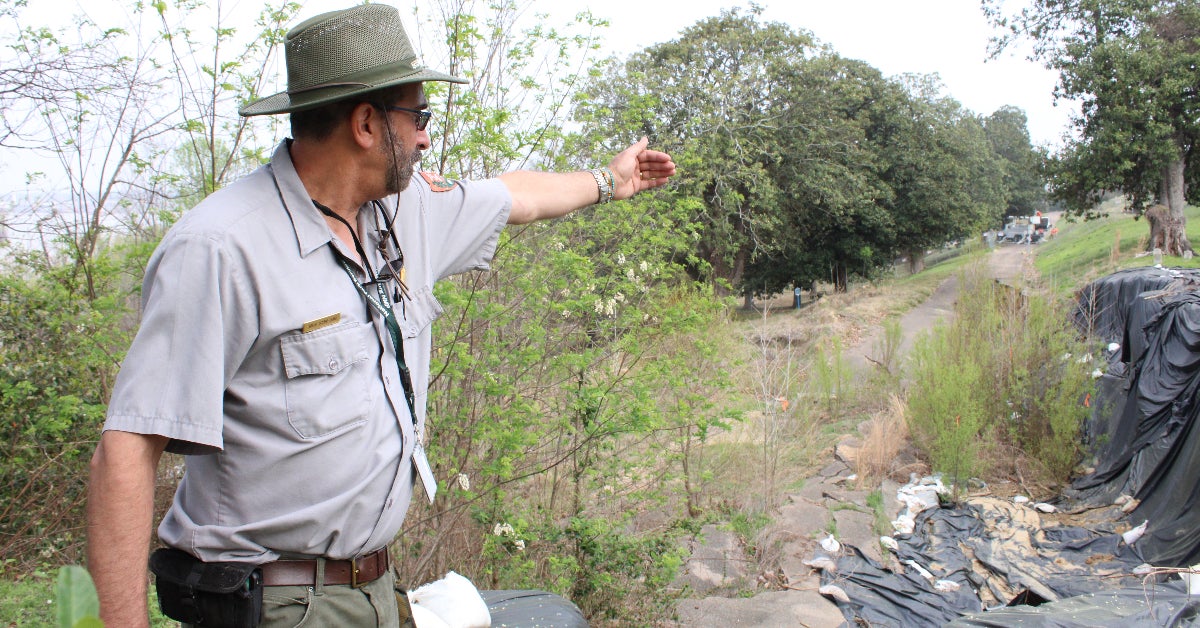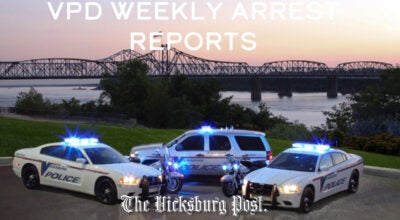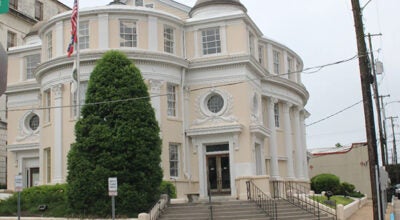‘A Real Deep Connection’: Military Park to disinter, analyze and stabilize U.S. Colored Troop graves in large-scale project
Published 4:23 pm Tuesday, March 7, 2023

- Archaeologist John Schweikart points out areas affected by erosion at the National Cemetery in the Vicksburg National Military Park. Work will soon be underway to disinter graves and repair a slide area affecting the graves of U.S. Colored Troops. (Photo by John Surratt | The Vicksburg Post)
A significant portion of the estimated 6,000-plus graves of U.S. Colored Troops in the Vicksburg National Cemetery will soon add a new chapter in history.
Slightly more than three years after a massive landslide in the National Cemetery at the Vicksburg National Military Park destroyed a portion of the cemetery road, exposed graves and threatened others, the Vicksburg National Military Park is beginning an ambitious project to repair the erosion damage, restore the graves and learn more about the people whose remains occupy them.
It was Feb. 11, 2020, when a park maintenance crew noticed cracks in the road running through an area of the cemetery designated for the bodies of U.S. Colored Troops. The area was closed to traffic as a precaution and by the next morning, the soil under the road collapsed, taking it and exposing the graves.
Presently, a section of that area is covered with a black plastic tarpaulin.
“This is the area that is still an active or an exposed face,” said park archeologist John Schweikart. “We’re trying to reduce that loss of soil as much as possible when we get those rainstorms and windstorms that come through, which is why we got this plastic thing. This is a temporary fix. This is what we want to resolve.”
The 2020 slide was not the cemetery’s first, he said.
“We have pictures from one in 1933, we have ones from 1975 and pictures from 2020; we found a grave under pavement (after the 2020 slide),” he said.
Schweikart said he decided to extend the tarpaulins after he arrived at the park in May 2022.
“This was about 8 to 9 feet high in Johnson grass,” he said, pointing to the area. “This is primarily just to knock the grass down (for the archeologists).”
The Archeologists’ Role
The work to restore the damage in the cemetery begins with the archeologists.
PeleoWest, a Phoenix, Ariz., company that specializes in archeology and restoration services, has been hired by the National Park Service to disinter the bodies and remove the monuments and grave markers from the affected area.
The team will consist of a principal investigator, bioarcheologists/osteologists and multiple qualified field archeologists.
Schweikart will monitor and manage all aspects of the burial recovery in conjunction with the principal investigator. Besides dealing with the graves in the eroded area, archeologists will also be looking for any graves that may have moved with the slide. Schweikart said the park service has used cadaver dogs to search for possible remains.
After they are exhumed, the bodies will be taken to a laboratory on the park grounds and kept there until the erosion-damaged area is repaired.
DNA and Isotope Analysis
“They’re going to be taken back to the lab at the restoration shop where they will be sorted, cataloged, analyzed; DNA samples will be taken and samples appropriate for isotope analysis so that if the consulting parties want that work done, those samples will already be ready, but that’s not part of this project,” Schweikart said.
At the time the burials began in the cemetery, he said, the different terraces were segregated by race and largely by regiment, “so we don’t know who these individual soldiers were, but the records do indicate where their burials came from in the surrounding area.
“So many of these men, of the unknowns, actually died when they were being treated by a doctor at a field hospital over by Culkin Road operated by a private physician,” he said. “That may help us if we can do a little more research on where specific USCT regiments were stationed during the war, particularly where they were utilizing field hospitals. That may help us identify what specific regiments were involved.”
Once the bodies are removed, work will begin on the project to stabilize the eroded area and begin repairs.
Lingering Issues and Solutions
Presently, the area still has its problems.
“When we get heavy rains, Given Hill Road here almost acts like a flume,” Schweikart said, pointing to a spot at the top of the road. “It’s amazing to watch; you just get literally a sheet of water coming across here. It pours through here and it’s created basically a waterfall. I’ve been here where you just see a gush of, you know, a 10- to 12-foot high spillway coming right down.”
The water, he said, is cutting down into the eroded area and washes down below.
“We’re trying to stabilize this,” he said. “But the key is that that area that’s the steep part covered in black we’re trying to protect that from this overwash, as well as rain and wind coming in.”
Contractors working under the U.S. Army Corps of Engineers Vicksburg District will do the erosion repairs, said Brendan Wilson, the park’s chief of interpretation, education and partnerships.
Schweikart said the repairs will involve a “soldier pile wall,” a concrete wall with pilings driven into the bedrock. Once the repairs are made, the remains will be returned to the graves.
Linking Past and Present
He said cemetery and grave restorations will help provide a link between Vicksburg residents and the park.
“What really makes this project, I think, have great potential meaning is getting that interplay and hearing those voices from the people of Vicksburg, many of them who might be descendants of some of these gentlemen,” Schweikart said. “That, in a sense, has been kind of the silver lining so far in this; that I think we’re at a point where we’re going to be able to bring a real deep connection for a lot of people in Vicksburg to the men buried here that may not have been there (before).
“And I find that most humbling and the most inspiring part of what we’re doing,” he added. “I think it’s (the restoration) one of a kind; there are many national parks and about 15 of them that have national cemeteries. Many of them also have issues with erosion and older trees and damaged headstones, but nothing on the scale of this. This is truly unique.”
Click here to learn how one USCT’s family is marking the project with a memorial ceremony this Saturday.






